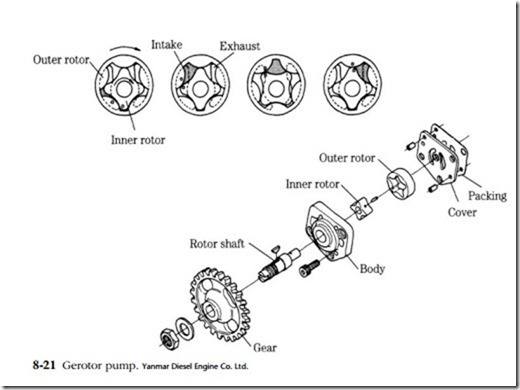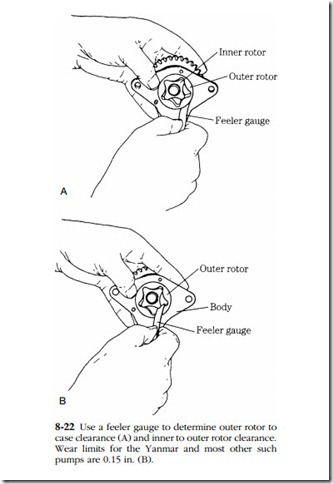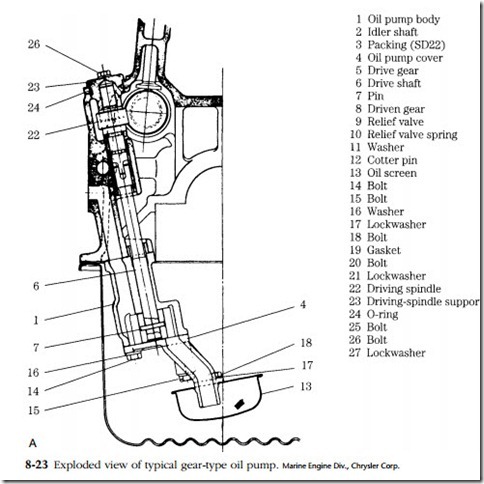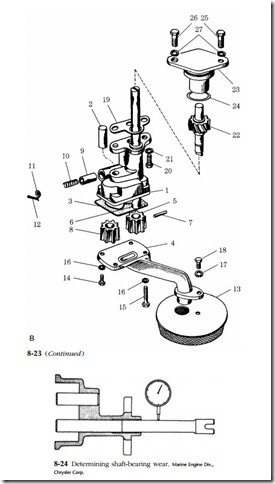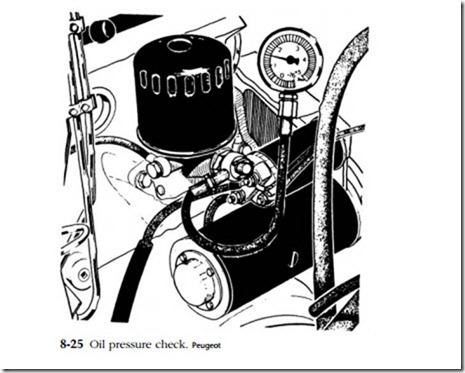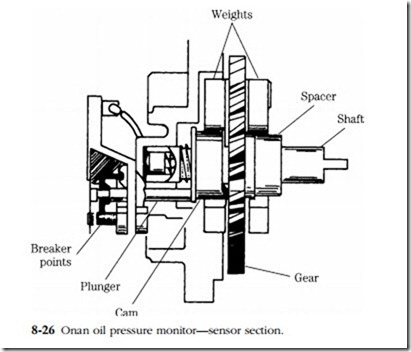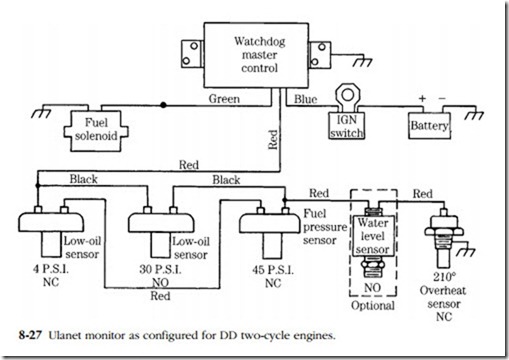Filters
All contemporary engines employ full-flow filtration, using single or tandem paper-element filters in series with the pump outlet. Pleated paper filters can trap particles as small as 1 1-m but are handicapped by limited holding capacity. Consequently, such filters incorporate a bypass valve that opens to shunt the element when the pressure drop reaches about 15 psi (Fig. 8-18), an action that should trigger a warning lamp on the instrument panel (Fig. 8-19). Otherwise the operator should occasionally feel the filter canister to verify that warm oil is circulating.
The Ford 2.3L filter consists of two concentric elements, one in series with the oiling circuit, the other in parallel (Fig. 8-20). As long as the bypass valve, shown at the top of the drawing, remains seated, pump output passes through the outer, series-connected element and into the lubrication circuit. Pump delivery rates are greater than the system requires and the surplus migrates through the inner filter and returns to the sump through the 9-mm orifice at the base of the assembly. I have been unable to obtain precise data for this engine, which was designed in Japan. However, standard design practice is to calculate diesel lube oil requirements as 0.003 times the ratio of oil to piston displacement times rpm. Pumps are then sized to meet twice these requirements. If this holds, the parallel filter makes a major contribution.
The most important single maintenance activity is to change the oil and filter on the engine-maker’s schedule, which is more demanding than suggested for equiva- lent spark ignition (SI) engines. A turbocharger increases bearing loads and blowby, further shortening oil and filter life.
The final steps in an overhaul or rebuild are to prime the oil pump by rotating the shaft with the impeller submerged in a container of clean motor oil, fill the tur- bocharger cavity and feed line, and pressurize the oiling circuit. The latter is accom- plished by connecting a source of oil pressure to the main distribution cavity, usually by way of the oil-pressure sender tap. This step is sometimes omitted and the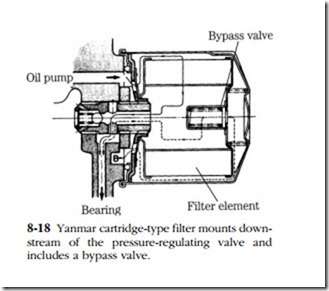
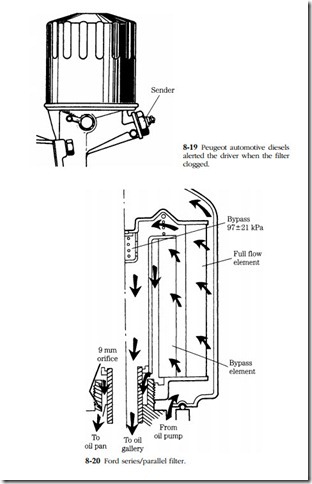
bearings—even though preoiled during assembly—suffer for it. The system must be pressurized after a new camshaft is installed.
Any repairs involving the turbocharger should be followed by disconnecting the oil return line and cranking until flow is established.
Before start-up after routine oil and filter changes, it is good practice to dry- crank the engine until the panel gauge indicates that oil pressure has been restored.
Lube oil
Oil collects moisture from condensation in the sump and is the repository for the liquid by-products of combustion. These by-products include several acid families that, even in dilute form, attack bearings and friction surfaces. No commercially practical filter can take out these contaminants. In addition oil, in a sense, wears out. The petroleum base does not change, but the additives become exhausted and no longer suppress foam, retard rust, and keep particles suspended. Heavy sludge in the filter is a sure indication that the change interval should be shortened, because the detergents in the oil have been exhausted. In heavy concentrations water emulsifies to produce a white, mayonnaise-like gel that has almost no lubrication qualities.
Oil that has overheated oxidizes and turns black. (This change should not be confused with the normal discoloration of detergent oil.) If fresh oil is added, a reac- tion might be set up that causes the formation of hard granular particles in the sump, known as “coffee grounds.”
Oil change intervals are a matter of specification—usually at every 100 hours— and sooner if the oil shows evidence of deterioration. Most manufacturers are quite specific about the type and brand to be used. Multigrade oils (e.g., 10–30W) are not recommended for some engines, because it is believed they do not offer the protection of single-weight types. Other manufacturers specify SF grades. As a practical matter this specification means that multigrade oils can be used. Brand names are important in diesel service. Compliance with the standards jointly devel- oped by the American Petroleum Institute, the Society of Automotive Engineers, and the American Society for Testing and Materials is voluntary. You have no guaran- tee that brand X is the equivalent of brand Y, even though the oil might be labeled as meeting the same API-SAE-ASTM standards. General Motors suggests that you discuss your lubrication needs with your supplier and use an oil that has been suc- cessful in diesel engines and meets the pertinent military standards. MIL-L-2104B is the standard most often quoted, although some oils have been “doped” with additives to meet the API standards. These additives cause problems with some engines often in the form of deposits around the ring belt. For GM two-cycles zinc should be held in between 0.07% and 0.10% by weight, and sulfated ash to 1.0%. If the lubricant contains only barium detergent-dispersants, the sulfated-ash con- tent can be increased by 0.05%. High-sulfur fuels might call for low-ash series 3 oils, which do not necessarily meet military low-temperature performance standards. Such oils might not function as well as MIL-L-2104B lubricants in winter operation.
Oil pumps
The Gerotor pump shown in Fig. 8-21 is gear-driven; a more common practice is to drive pumps of this type directly from the crankshaft. Like the Wankel engine, which employs a similar trochoidal geometry, operation is somewhat difficult to visualize on paper and obvious in the hardware. The inner rotor, which has one lobe less than the outer rotor, “walks” as it turns, imparting motion to the outer rotor and simultaneously varying the volume of the working cavity (shaded in the drawing). Volume change translates as a pressure head.
The clearance between the rotors and the end cover is best checked with Plasti-Gage. Plasti-Gage consists of rectangular-section plastic wire in various thicknesses. A length of the wire is inserted between the rotors and cover. The working clearance is a function of how much the wire is compressed under assembly torque. The package has a scale printed on it to convert this width to thousandths of an inch. Plasti-Gage is extremely accurate and fast. The only precautions in its use are that the parts must be dry, with no oil or solvent adher- ing to them, and that the wire must be removed after measurement. Otherwise it might break free and circulate with the oil, where it can lodge in a port. Typical end clearance for a Gerotor pump is on the order of 0.003 in. Of course, all rub- bing surfaces should be inspected for deep scratches, and the screen should be soaked in solvent to open the pores.
Other critical specifications are the clearance between the outer rotor and the case (Fig. 8-22A) and the approach distance between inner and outer rotors (B).
Camshaft-driven gear-type pumps are the norm (Fig. 8-23). Check the pump for obvious damage—scores, chipped teeth, noisy operation. Then measure the clear- ance; the closer the better as long as the parts are not in physical contact.
End clearance can be checked by bolting the cover plate up with Plasti-Gage between the cover and gears, or with the aid of a machinist’s straightedge. Lay the straightedge on the gear case and measure the clearance between the top of
the gear and the case with a feeler gage. When in doubt, replace or resurface the cover. Check the diameter of all shafts and replace as needed. The idler gear shaft is typically pressed into the pump body. Use an arbor press to install, and make certain that the shaft is precisely centered in its boss. Allowing the shaft to cant will cause interference and early failure. Total wear between the drive shaft and bushing can be determined with a dial indicator as shown in Fig. 8-24. Move the shaft up and down as you turn it. Check the backlash with a piece of solder or Plasti-Gage between the gears. For most pumps this clearance should not exceed 0.018 in.
In general, it is wise not to tamper with the pressure relief valve, which might be integral with the pump or at some distance from it. If you must open the valve, because of either excessive lube oil pressure or low pressure, observe that the parts are generally under spring tension and can “explode” with considerable force. Check the spring tension and free length against specs, and replace or lap
the valve parts as needed. When this assembly has been disturbed it is imperative that the oil pressure be checked, with an accurate instrument such as the gauge shown in Fig. 8-25.
Oil pressure monitoring devices
Because oil pressure is critical, it makes good sense to invest in some sort of alarm to supplement the usual gauge. Gauge failure is rare (erratic operation of mechanical gauges is usually caused by a slug of hardened oil impacted at the gauge fitting), but it does happen. Failure to shut down when pressure is lost will destroy the engine in seconds.
Stewart-Warner monitor Stewart-Warner makes an audiovisual monitor that lights and buzzes when oil pressure and coolant temperatures exceed safe norms. The indicator is a cold-cathode electron tube, which is much more reli- able than the usual incandescent bulb. Designed for panel mounting, the 366- T3 is relatively inexpensive insurance.
Onan monitor Onan engines can be supplied with an automatic shutdown feature. The system employs a normally on sensor element and a time delay relay. In conjunction with a 10 W, 1-D resistor, this relay allows the engine to be started. When running pressure drops below 13 psi, the sensor opens, causing the fuel rack to pull out.
The sensor (Fig. 8-26) is the most complicated part of the system. It has a set of points that should be inspected periodically, cleaned, and gapped to 0.040 in. When necessary, disassemble the unit to check for wear in the spacer, fiber plunger, and spring-loaded shaft plunger. The spacer must be at least 0.35 in. long. Replace as needed. Check the action of the centrifugal mechanism by mov- ing the weights in their orbits. Binding or other evidence of wear dictates that the weights and cam assembly be replaced. The cam must not be loose on the gear shaft.
Ulanet monitor The George Ulanet Company makes one of the most com- plete monitoring systems on the market (Fig. 8-27). It incorporates an optional water level sensor, overheat sensor, fuel-pressure sensor, and low- and high- speed oil sensors. For the GM 3-71 and 4-71 series, these sensors are calibrated at 4 psi and 30 psi, respectively.
Crankcase ventilation
The crankcase must he vented to reduce the concentration of acids and water in the oil. A few cases are at atmospheric pressure; others (employing forced-air scavenging) are at slightly higher than atmospheric; and still other systems run the crankcase at a slight vacuum to reduce the possibility of air leaks. The vapors might be vented to the atmosphere or recycled through the intake ports. In any event, the system requires attention to ensure that it operates properly. A clogged mesh ele- ment or pipe will cause unhealthy increases in crankcase pressures, forcing oil out
around the gaskets and possibly past the seals, as well as increasing oil consumption. Figure 8-28 shows a breather assembly with check valve to ensure that the case remains at less than atmospheric pressure.
